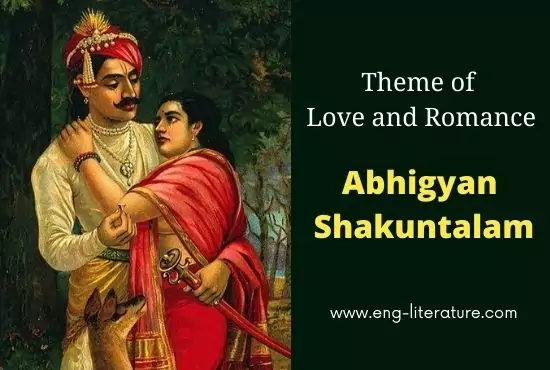Theme of Love and Romance in Abhigyan Shakuntalam
In the structural aspects of the Abhigyan Shakuntalam, it becomes evident that apart from the curse motif and the restoration motif, there is present “a pattern of dream, illusion and of forgetfulness-recollection-recognition, all of which are intricately interwoven. One also finds a fine blend of romance and fairy tale with the elements of comedy in Shakuntalam”, Observes Romila Thapar. The meeting of king Dushyanta with Shakuntala also symbolizes the interaction of two worlds, and this union of a man and Nature is a celebration of joyous festival of love and a dream of fulfillment. The propelling force in Kalidasa‘s poetry is to see Nature not as a setting for man and a backdrop to human drama but to perceive it as possessing life of its own and as related to human world in many complex ways. Romance and love lie at the core of the play.
In the description of the love scenes in the play, an extravagance of emotion and passion has been displayed. In the play Abhigyan Shakuntalam, myth, legend and dream-vision have been blended with top graphical and conversational dimension to give this love story more depth and a multilayered texture. The world in Shakuntalam is a world of fairies, enchantment and myths. The hero of the play Dushyanta meets Shakuntala in the forest and this meeting is similar to the meeting between Savitri and Satyavan in Sri Aurobindo’s epic Savitri. The forest serves as the meeting point for the couples and Nature has been used as a backdrop to enhance the romantic effect of the romantic tale. The opening lines take the readers into a world of romance and adventure. The king leaves his kingdom to enter a new kingdom. It is a mythical world where the thin border line between realism and romance vanishes.
The opening pages of the play present Shakuntala as the child of Nature and often she is compared with flowers like Jasmine. The king belongs to other world which is alien to Nature. When Shakuntala visits the king, she suffers. This is her movement from Nature to the materialistic world. Later when the king is left behind by Shakuntala, he is filled with a feeling of remorse. Twice he enters the sacred region, first the tapovan, the hermitage of Kanva, and later the hermitage of Maricha. Before the king can enter this world, he has to be purified. First he proves his worth by battling the forces of darkness and disorder that threaten the order of the universe, observes Thapar.
So Kalidasa presents two different worlds in this play. They are the green world of Nature and the gilded world of the royal court which are poles apart. There is no reconciliation Act I and VII present the hermitage of Kanva and Maricha that enjoy the bliss of Nature. Imagery is rich with the descriptions of flowers and honey bees hovering over them and the perennial water springs in the Himalayas. The colour imagery suggests the display of colour from the natural world, the flora and fauna. Here the lotus is golden and the place for meditation a lush green sylvan surrounding with deer jumping around the jeweled caves where celestial nymphs dance. The Hemkoot mountain is the abode of sage Maricha which represents a world of perfection. It is rightly said that words are the key to open doors for imagination on its journey of exploration into the fictional world.
Kalidasa has also employed the device of irony in Abhigyan Shakuntalam to heighten the emotional impact of the situation. The use of the curse motif and the ring motif justifies itself. It provides an explanation to the recognition or abhiryan’ of Shakuntala. In fact, this recognition is for Dushyanta who knows the truth only after losing his wife. In the beginning, the king is infatuated with Shakuntala’s perennial beauty and he also enjoys her carnally. He fails to see and experience the transformative side of her personality as he finds her, “..an object of Nature. She is flower to smell, a gem to hold and an ornament to wear. She is hardly a person to him. It is only at the end of the play that he sees her as a person and knows her truly.” Rightly observes Romila Thapar.
All the romantic Sanskrit plays, poets have employed highly poetic as well as erotic imagery to describe the beauty of the heroine and the love making. Throughout the play, she is seen constantly changing, developing into a mature woman playing multiple social roles of a wife, a mother and a woman with a transformative touch, in Jungian terms. When one compares Shakuntala of the first Act with the Shakuntala of Act VII, it shows her passage from innocence to experience from the abstract to the concrete, from the hermitage to Hastinapur, and finally from separation to reunion.
Also Read:
In the court of king Dushyanta, the repudiation of Shakuntala arouses the karuna-rasa (pity) when she is literally deserted by her lover who himself sits on the throne of Dharma. After their separation, the two lovers under go a long tapasya and later their reunion takes place in the hermitage of sage Maricha. Shakuntala’s tale can also be studied in the light of Campbellion stages of separation, initiation and return. As a literary text, the play is a triumph in its subject matter, thematic presentation, characterization, intersecting symbols and tones and evocative imagery, striking metaphors and the theme of love in its various shades.

Hello, Viewers! Besides being the Founder and Owner of this website, I am a Government Officer. As a hardcore literary lover, I am pursuing my dream by writing notes and articles related to Literature. Drop me a line anytime, whether it’s about any queries or demands or just to share your well-being. I’d love to hear from you. Thanks for stopping by!

Thankyou!